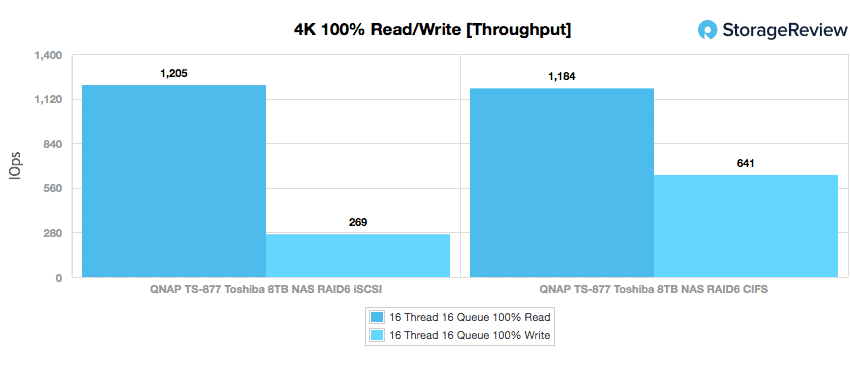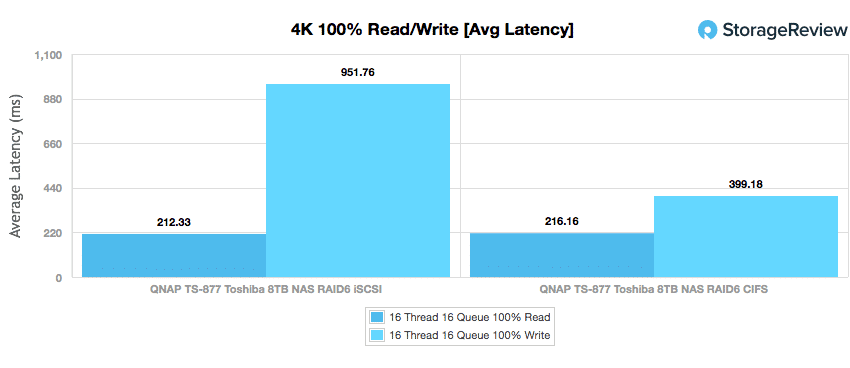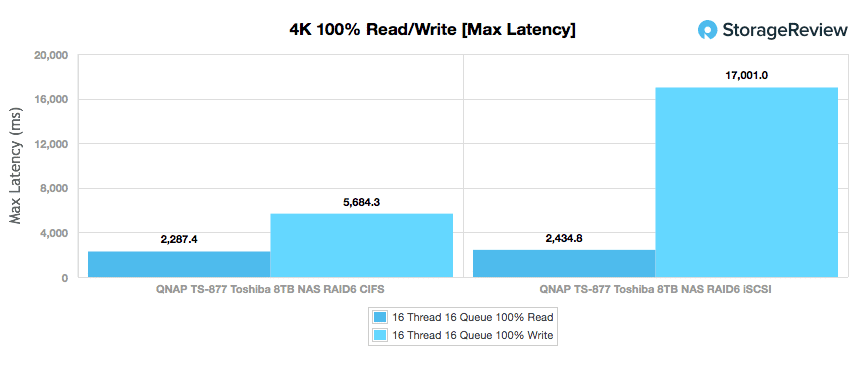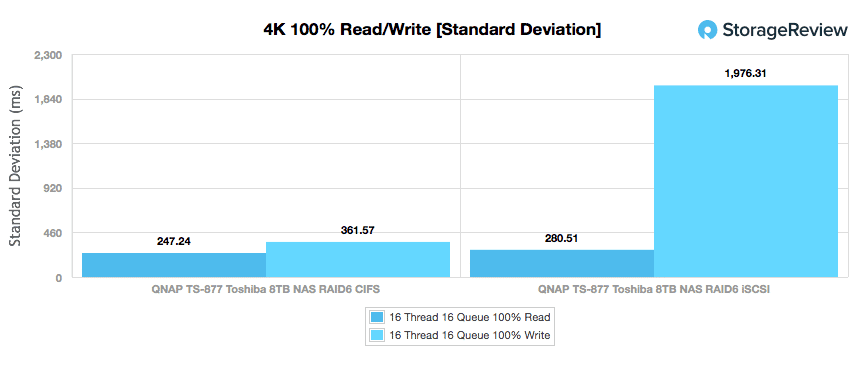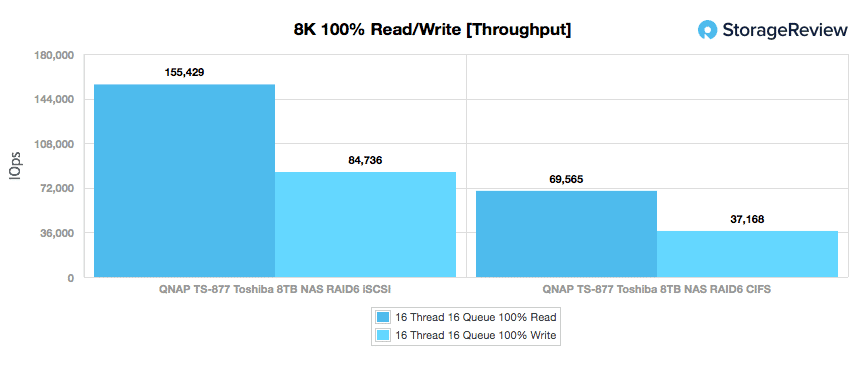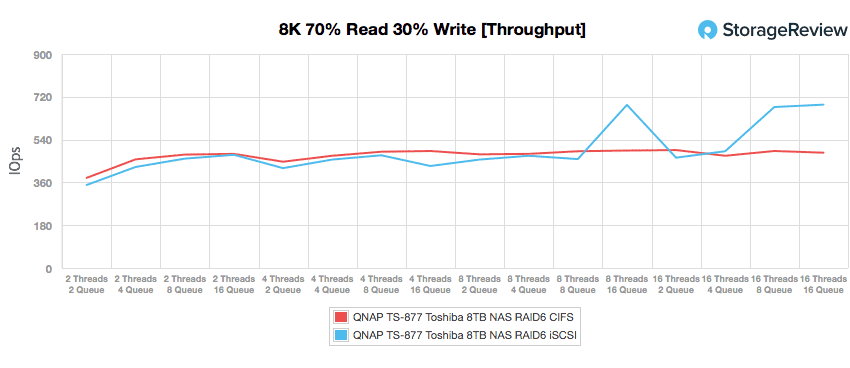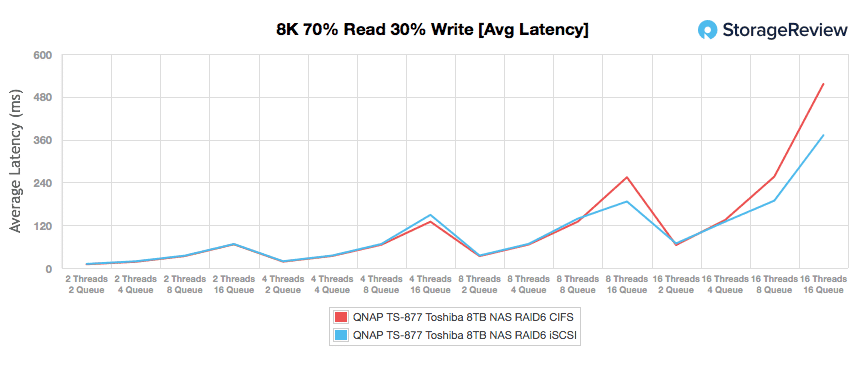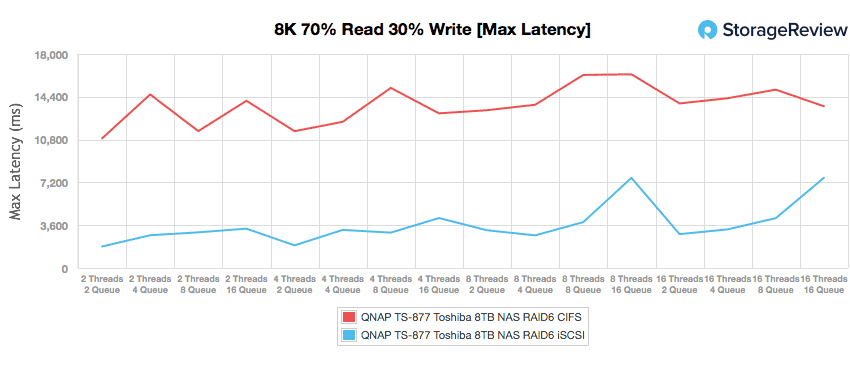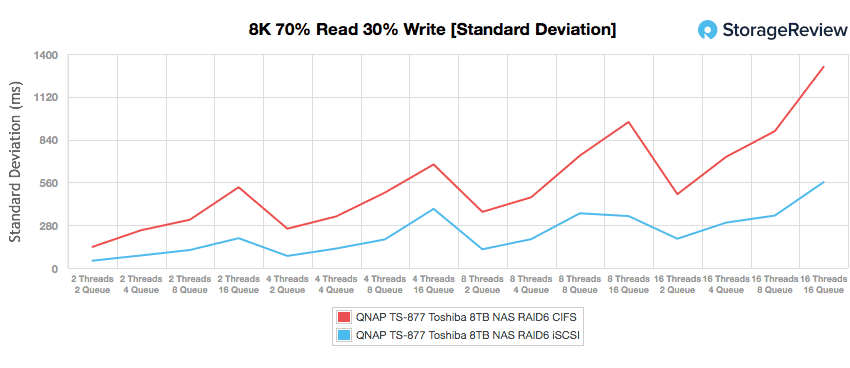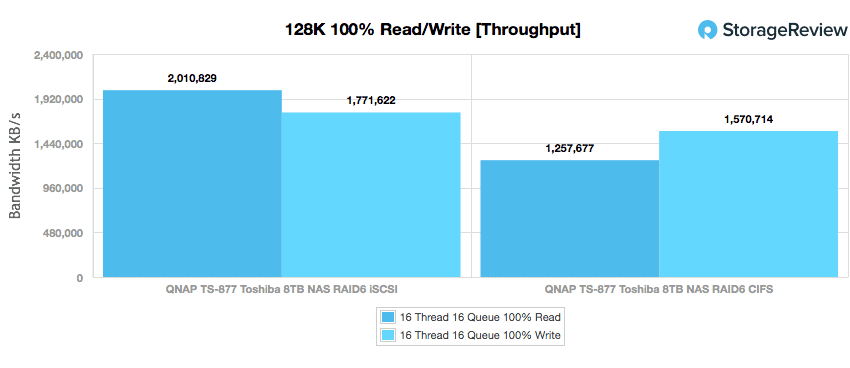
The QNAP TS-877 is the 8-bay model from the company’s TS-x77 line, which is touted as the industry’s first Ryzen-based NAS and designed specifically for video editing and other high-demand multi-threaded applications. Announced back in November 2017, the TS-877 features up to 8-cores/16-threads (Turbo Core up to 3.7 GHz), SSD caching and is specifically designed to perform well under resource-intensive workloads such as with VDI, server virtualization, private cloud and 4K use cases. It features USB 3.1 Gen2 10Gbps Type-A and Type-C ports, and three PCIe expansion slots, the latter which supports PCIe devices such as graphics cards, 10GbE/40GbE NICs, PCIe NVMe SSD, USB 3.1 expansion cards, and QM2 cards.
The QNAP NAS can also be outfitted with AMD Radeon and NVIDIA graphics cards, allowing for video processing and GPU-passthrough to VMs.
The TS-877 also comes equipped with two 2.5-inch SSD slots used specifically for caching. Coupling this with Qtier technology, you should be able to noticeably improve IOPS performance. As such, QNAP quotes their 8-bay NAS to reach 2,344MB/s read and 1,761MB/s write via 2 x 10GbE Sequential Transfer, while Encrypted Sequential Transfer is expected to hit 2,301MB/s read and 1,739MB/s write. The TS-877 also features four DDR4 UDIMM slots, which that support up to a hefty 64GB of memory
Like all QNAP NAS solutions, the TS-877 is powered by QTS, QNAP’s operating system that features a range of applications and functions to improve management efficiency, personal productivity, multimedia, and other entertainment and workflow use cases. QTS is highlighted by its built-in App Center with hundreds of install-on-demand apps.
QNAP TS-877 Specifications
- CPU: Processor: AMD Ryzen 7 1700 8-core/16-thread 3.0 GHz processor, Turbo Core 3.7 GHz
- Architecture: 64-bit
- Graphics: Optional (with PCIe expansion card)
- Encryption Engine: AES-NI
- System Memory: 16 GB DDR4 (2 x 8 GB)
- Maximum Memory: 64 GB (4 x 16 GB)
- Memory Slot: 4 x UDIMM DDR4
- (For dual- or quad-DIMM configurations, you must use a pair of identical DDR4 modules.)
- Flash Memory: 5GB (DOM for dual OS)
- Drive Bay:
- 6 x 3.5-inch SATA 6 Gbps bays
- 2 x 2.5-inch SATA 6 Gbps bays
- Drive Compatibility
- 3.5-inch bays:
- 3.5-inch SATA hard disk drives
- 2.5-inch SATA hard disk drives
- 2.5-inch SATA solid state drives
- 2.5-inch bays:
- 2.5-inch solid state drives
- M.2 SSD Slot: 2 x M.2 2240/2260/2280/22110 SATA 6Gb/s SSDs
- SSD Cache Acceleration Support
- 3.5-inch drive bays 1 to 6
- 2.5-inch drive bays 1 to 2
- M.2 slots 1 to 2
- Optional: SSD using PCIe expansion slot
- Hot-swappable: Yes
- 10 Gigabit Ethernet Port
- Optional: With PCIe expansion card
- Gigabit Ethernet Port: 4 x RJ45
- PCIe Slot:
- 1 x PCIe 3.0 x8
- 1 x PCIe 3.0 x4
- 1 x PCIe 2.0 x4
- USB Port:
- 2 x USB 3.1 10 Gbps
- Back: 1 x USB 3.1 10 Gbps Type-C
- Back: 1 x USB 3.1 10 Gbps Type-A
- 6 x USB 3.0
- Front: 1 x USB 3.0 Type-A (Note: It comes with the One-Touch Copy button)
- Back: 5 x USB 3.0 Type-A
- HDMI Output Optional: With PCIe expansion card
- Audio • 2 x 3.5 mm dynamic microphone jacks
- 1 x 3.5 mm line-out jack
- 2 x speakers
- Display Panel: Monochrome backlit LCD display with Enter and Select buttons
- USB One Touch Copy: Front: USB 3.0 Type-A
- Form Factor: Tower
- Dimensions (H x W x D)
- 231.9 x 292.8 x 319.8 mm
- 9.13 x 11.53 x 12.59 inch
- Net Weight 8.86 kg (19.53 lbs)
- Shipping: 10.69 kg (23.57 lbs)
- Power Supply Unit: 450W, 100-240V AC, 50/60Hz
- Fan: System: 2 x 80 mm
- CPU: 2 x 90 mm
- Operating Temperature & Relative Humidity: 0 ~ 40˚C ( 32˚F ~ 104˚F ), 5 ~ 95% RH non-condensing, wet bulb: 27˚C (80.6˚F)
- Security Slot: Kensington security slot
Design and Build
The TS-877 is a rugged yet nice-looking tower form factor NAS, keeping with the same look and feel as previous models including QNAP’s usual gold finish and company branding at the top right. This front-accessible NAS has 6 hotswappable drive bays below while the twin stacked SSD bays are located at the top left of the NAS. Each bay features a locking mechanism and status LEDs.
QNAP’s updated LCD display panel resides next to the two SSD cache bays, providing users with an easy way to restart and power off the NAS, configured the LCD password, edit and view network settings and get a quick glance of what’s up with the system, physical hard drives and volumes. QNAP makes it pretty seamless to do all these actions via their enter and Select buttons. At the bottom right is the power button, USB One-Touch Copy port/button are stacked neatly at the bottom right.
The back of the TS-877 is home to all its connectivity as well as QNAP’s heat sink. At the top left are the 2 PCIe slots (and their covers). Moving down are their 3.5 mm line-out and dynamic microphone jacks, console port, 1x USB 3.0 and 2x 3.1 gen 2 10Gps Type-A ports, 4x Gigabit Ethernet (RJ45) ports, three more USB 3.0 ports and the power input and switch. A large portion of the back panel also shows two large fans to exhaust the heat.
Both PCIe 3.0 x4 slots and the DIMMs are accessed via the right panel. You will have to completely remove the cover to access these components by removing the screws the secure the cover and then simply pulling the civer off. The PCI 3.0 x8 slot is accessed on the left panel.
Testing Background and Comparables
Our first benchmark measures the performance of random 4k transfers comprised of 100% write and 100% read activity. In this workload, the TS-877 recorded its best read-throughput under an iSCSI file level configuration with 1,205 IOPS. Writes were most effective under the block-level CIFS test with 641 IOPS.
Moving on to average latency, the TS-877 posted 951.762ms write and 212.329ms read in iSCSI whereas CIFS showed 399.175ms write and 216.158ms read.
Looking at maximum latency shows the TS-877’s best read performance in CIFS this time 2287.4ms versus the iSCSI connectivity’s 2434.8. Writes showed a much biggest discrepancy with 5,684.3ms and 17,001 for CIFS and iSCSI, respectively.
Standard deviation shows us a good visualization in terms of consistency. Here, the TS-877 configured in CIFS showed its best performance with 247.235ms read and 361.569ms write.
The next test again puts the drives under 100% read/write activity; however, we will be using 8K sequential throughput for this test. In this scenario, the TS-877 showed its best performance by a significant margin in iSCSI, posting 155,429 IOPS read and 84,736 write while CIFS connectivity showed 69,565 IOPS read and 37,168 IOPS write.
Compared to the fixed 16 thread, 16 queue max workload we performed in the 100% 4k write test, our mixed workload profiles scale the performance across a wide range of thread/queue combinations. In these tests, we span workload intensity from 2 threads and 2 queue up to 16 threads and 16 queue. In throughout, the TS-877 recorded its best performance using iSCSI connectivity with a range of 349 IOPS in burst and 687 IOPS.
Looking at average response times shows a range of 11.41ms to 372.23ms in iSCSI and 10.49ms and 526.12ms in CIFS.
In maximum latencies, the TS-877 again recorded its best performance via iSCSI, boasting a range of 1,808.42ms through 7,588ms. CIFS showed a higher latency range with 10,900.44ms though 13,02.5ms.
Standard deviation showed 137.98ms to 1,316.47ms in CIFS and 47.92ms to 561.78ms in iSCSI.
Our last workload in our small NAS Synthetic Workload testing consists of the 128k test (100% write and 100% read activity), which is a large block sequential test that shows the highest sequential transfer speed. Here, the TS-877 recorded its top read and write speeds of 2.01GB/s and 1.77GB/s, respectively, with iSCSI, which was noticeably faster than CIFS’s 1.26GB/s read and 1.57GB/s write.
Conclusion
The TS-877 had a solid showing as the industry’s first Ryzen-based NAS. Designed for VDI, server virtualization, private cloud and 4K and other high-demand multi-threaded applications, the TS-877’s performance was highlighted by its Turbo Core CPU (up to 3.7 GHz at 8-cores/16-threads) and double SSD caching bays. It also features the USB 3.1 and 3.0 ports while adding a ton of flexibility with its three PCIe expansion slots, which support PCIe devices such as graphics cards, 10GbE/40GbE NICs, PCIe NVMe SSD, USB 3.1 expansion cards, and QM2 cards.
As for the details of its performance, we ran the TS-877 through tests in configurations of both CIFS (file-level) and iSCSI (block-level) storage connectivity via 10GbE. In our random 4K access benchmark, the TS-877 recorded its best read-throughput under an iSCSI file-level configuration with 1,205 IOPS, while writes were most effective under the block-level CIFS test with 641 IOPS. In our 8K sequential throughput test, the TS-877 recorded 55,357 IOPS write and 55,757 IOPS read, while CIFS posted 55,100 IOPS and 57,057 IOPS, respectively. In our large block sequential test, the TS-877 recorded its top read and write speeds in iSCSI with 2.01GB/s and 1.77GB/s, respectively, which was noticeably faster than CIFS’s 1.26GB/s read and 1.57GB/s write.
Overall the AMD-powered QNAP TS-877 offered plenty of punch in regards to performance, has lots expansion options and gave users a drive layout to offer caching capabilities if desired. For users in the market for a small-office or branch-office NAS, the TS-877 is a worthy offering with consideration.
Sign up for the StorageReview newsletter


